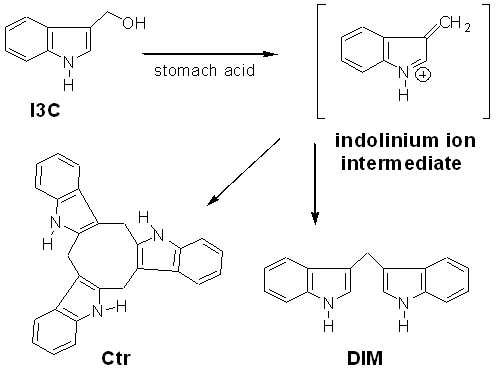Overview of Diindolylmethane (DIM) Formation
Indole-3-carbinol (I3C) is the immediate molecular precursor of Diindolylmethane (DIM). Upon consumption of Brassica vegetables, the enzyme myrosinase is released from the plants, which cleaves glucobrassicin to release I3C.

Structures of I3C and Two Acid Reaction Products.
I3C has been shown to degrade fairly readily in aqueous systems to a reactive indolinium ion intermediate. In the environment of the stomach, the indolinium ion reacts with I3C or other indolinium ions to form oligomers such as Diindolylmethane (DIM) and the Cyclic Trimer (Ctr). In cellular environments, the indolinium ion binds non-specifically with free thiols on proteins and glutathione.
Due to I3C’s high degree of reactivity and instability within the body, DIM is more recommended as a dietary supplement than I3C as all of I3C’s derivatives and their variety of biological activities have not been fully explored. DIM, on the other hand, is more stable and less reactive as a compound, with extensive human clinical studies on its use as a dietary supplement.
News Brief From Berkeley
A Bioavailable Diindolylmethane Immune Support Formula has been launched with technology exclusively licensed from UC Berkeley as a fund-raiser for nature-based cancer therapeutics research. For more information about this formula, please visit: www.BerkeleyFormula.com.

